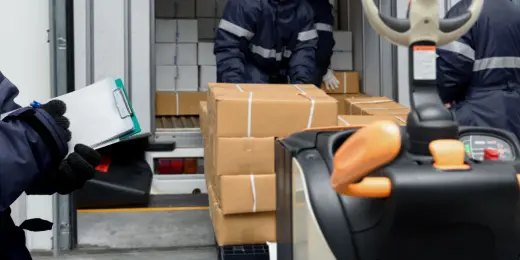What is Cross Docking?
Cross docking refers to the process of unloading products directly from the truck into a new outbound vehicle, eliminating the need for long stays at warehouses. That way, products on the way to the same area are consolidated into small groups for more efficient delivery. Because of this nature, organizations that utilize cross-docking move fast.
In essence, cross docking eliminates the need to store goods. When an organization implements cross-docking, they remove the storage link to the supply change, leading to speedier deliveries, less downtime, and better overall efficiency.
The ultimate goal of cross docking is to create an easier delivery process. That way, organizations boost customer satisfaction rates with faster deliveries while saving time and effort in the actual delivery process.
Types of Cross Docking
Typically, organizations adopt either pre-distribution or post-distribution cross-docking approaches. Let’s take a closer look at these two approaches to cross-docking.
Pre-Distribution
With pre-distribution cross-docking, organizations determine the customer and delivery point before trucking or shipping out the products. This means that the goods are sorted, packed, and shipped based on pre-determined instructions.
Post-Distribution
With post-distribution cross-docking, goods enter the cross-docking facility before the customer is identified. With this approach, the goods spend more time in the cross-docking facility. However, the organization has a bit more time to determine trends and make more informed decisions about their shipments.
Advantages
Cross-docking creates a simpler supply chain. This makes it easier for goods to arrive to customers, increasing satisfaction, performing an efficient order fulfillment, and giving your organization a competitive edge. On the flip side, it also reduces costs within the organization, offering financial benefits as well.
Here are some of the other benefits that might make you want to adopt cross-docking within your organization:
Saves Time
Firstly, cross-docking saves time. Organizations that use cross-docking don’t need a storage warehouse for their goods. Instead, from a dock—they unload their products right onto new delivery vehicles for faster movement. That way, there is less time spent with the products in storage, not moving anywhere.
Reduces Costs
Storing goods can cost a lot of money. When products are stored in a warehouse for a long time, organizations have to pay a fee to keep them. And over time, these fees can significantly add up and cost your business a lot.
But with cross-docking, you don’t have to pay for additional storage and inventory. That way, there’s a smaller inventory cost for the company, allowing you to use funds for other endeavors.
Reduces Material Handling
The more steps products have to go through before customers receive them, the higher the chance of product damage. Damaged products can cost a company a lot, whether in refunds to customers or replacing the product itself.
In traditional supply chains, products are handled a lot. This means there are many chances that a product can get damaged. But when using cross-docking methods, there are fewer people handling the products, reducing the number of damaged items.
Gives a Central Handling Site for Products
When you adopt cross-docking, the cross-docking facility turns into a storage and handling site for your products. Instead of having multiple facilities that hold goods, everything is moved to one place. This results in much simpler and smoother operations, increasing efficiency and productivity as well.
Industries that Benefit from Cross Docking
Typically, businesses that deal with importing and exporting products with high demand and consistent turnover can benefit from cross-docking. The process is very widely used in this industry. However, many other businesses can adopt the process and simplify their supply chain.
For example, one type of organization that can benefit from cross-docking is the one that sells time-sensitive products. If you stock up on items with a short shelf life, it’s important to distribute the items as quickly as possible. With cross-docking, products get to your stores faster, giving you more time to sell the product before the expiration date.
Some examples of industries that use and benefit from cross docking are retailers, package delivery firms, logistics companies, product manufacturers, and food and beverage companies.
Create Your Own Inspection Checklist
Eliminate manual tasks and streamline your operations.
Get started for FREE
When you bypass the storage process in the supply chain, it also becomes easier to deal with multiple suppliers. So, if you stock up on products that come from different sources, cross-docking could be a great way to make processes easier.
FAQs about Cross Docking
Cross-docking is a complicated process. And even if it can save organizations money and time, shifting to a cross-docking system requires a lot of investment and planning to execute it correctly.
Cross-docking is typically used to simplify the supply chain. Organizations with a simpler supply chain can send out products quicker, ensuring that stocks are always up in stores and customers receive their goods as soon as possible.
The biggest challenge of cross-docking is the cost of adopting the process. Cross-docking can save money in the long run, but adopting the process requires significant investment in logistics services, automation, and a transport fleet.
Adopting cross-docking within the organization requires a lot of planning and strategy. To start, it’s important to determine all the investments needed to buy equipment and put up the team. Then, the organization can slowly start implementing its strategy and eliminating the storage link in its supply chain.
The three main methods of cross-docking are continuous cross docking, consolidation cross docking, and deconsolidation cross docking.




